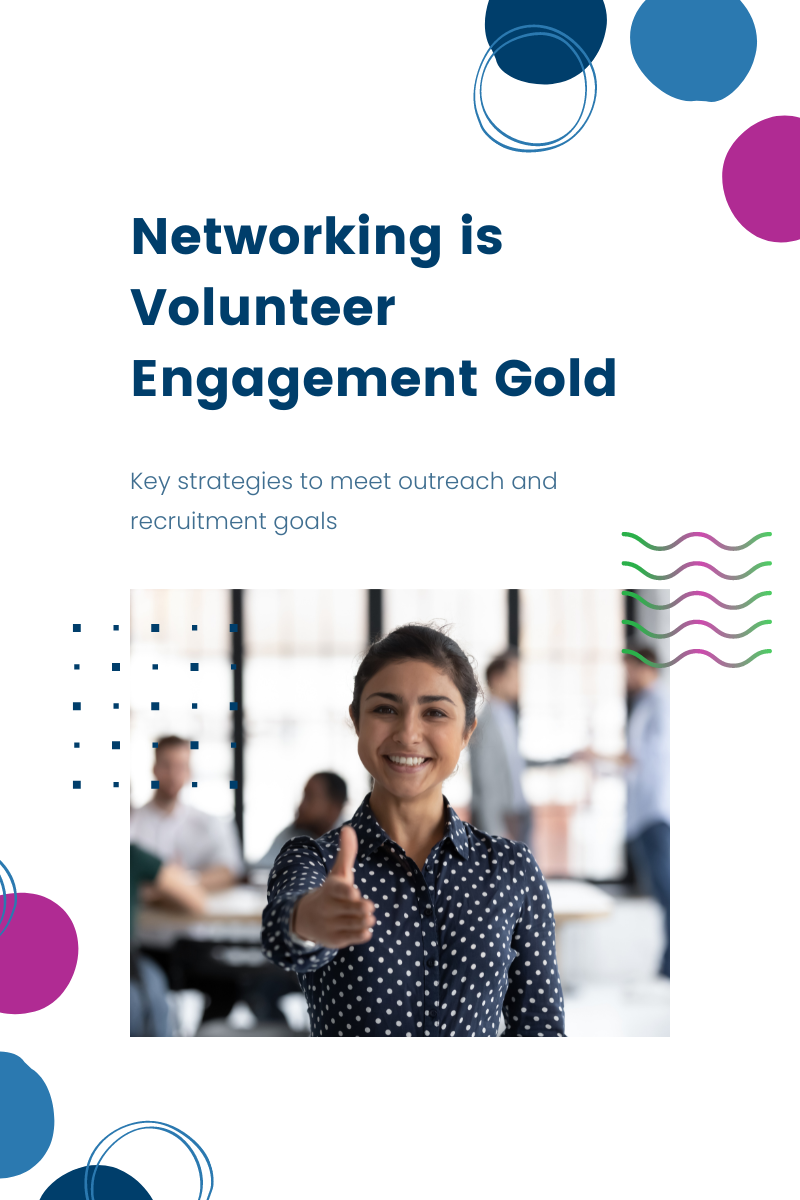Networking is Volunteer Engagement Gold
Networking is Volunteer Engagement gold and we have the key strategies to meet your outreach and recruitment goals. With volunteer recruitment being the biggest need within the profession, developing your networking skills might be your solution. SAVMA’s Roundtable Discussion on Networking identified key strategies:
Key Strategy: Do your homework
Before you attend an event, find out who will be in the room. If you cannot find out the specific individuals, get a general sense of the audience demographics from the host so you can build a plan. If you are attending a Chamber of Commerce event, you might want to meet business professionals that can join your Board of Directors. Compare that to attending a Public Health Awareness event where your goal might be to meet professionals of industry for your advocacy team. Getting a sense of who will be attending an event, or who has been invited will help you narrow your focus so you can maximize your time.
Recruitment Goal: Attend six Chamber of Commerce meetings with a Leadership Volunteer resulting in identification of no less than three candidates for leadership positions within the next 36 months.
Key Strategy: Be prepared for success
Do you remember the adage, “don’t judge a book by its cover?” Well one member shared a story of trying to avoid the “extreme extrovert” in the room at a networking event. It was clear that person was monopolizing whomever they were with, and our Volunteer Engagement Professional had a list of people to meet and didn’t want to get bogged down with one person. Well after getting seated with the extrovert, it turns out they became the best mentor and friend for our VEP.
After sitting with the story for a few minutes as a group, we also contemplated the idea that we often walk into rooms planning to fail. This is especially true when we lack the confidence or experience. Search out someone with the confidence or appeal you would like and ask them how they are doing that?
Professional Development Goal: Identify an “unexpected professional buddy” with skills, and experience, different than mine in a different profession who will provide peer coaching resulting in skills development and adaptave leadership development (be specific about which skills and be sure you will gain leadership development and that this person has adaptive leadership skills).
Key Strategy: Refer to your peers
Active listening came up repeatedly as a very useful strategy. There were a number of very good prompts suggested to motivate the person to whom you might be speaking to get them chatting. Regardless of what those great prompts were, all roads led to us listening rather than selling our pitches. So what happens when you get to the end of their big talk and you didn’t glean a match for anything in your organization? Refer to a peer! One of the best parts of professional association membership, is the ability to refer to your peers. If someone is not a fit for you, a warm hand off to your peer can be seemless. Make the recommendation that they reach out to XYZ organization because it sounds like they might be a great fit. We call this bless and release.
Recruitment Goal: To reduce the number of volunteer candidates in the application process that do not activate, while increasing the warm handoff referral process with peer agencies.
Key Strategy: Ask for help!
The last best networking strategy that came out of the Roundtable session was to ask for help from the host. No matter the organization, you were invited to attend (we hope) for a reason. They want you to be successful. Contact them ahead of time and find out who they want you to connect with as well. They might have ideas if you share your list of needs. Be sure you have crafted your needs to your audience. Your materials should very because not all positions will fit all audiences. You don’t usually ask a room full of drivers to become afterschool caregivers for example.
Outreach Goal: To deepen partner relationships and further develop tools for evaluating return on investment of membership costs. (Get a lists from Finance of all organization memberships and which ones you might be eligible to attend as a guest of a collegue. You will need to write reports about ROI after attending to track value.)
Networking, Volunteer Engagement Basics
We hope you found these strategies helpful. If you are very new to newtworking, or need a quick checklist here is a handy list:
- Bring your business cards. Too new for business cards, get your bosses cards, or the receptionists. As a volunteer engagement professional your team hopefully has a pile of blanks for the volunteers to use.
- Wear your agency name tag. It is branded, but be sure it has big font for easy reading. Tip for name tag placement: it goes on the upper-right shoulder, above your pocket. It directs a person’s eyes across from you to the appropriate place to read your tag when shaking hands.
- Know your “Big Three.” Skip the elevator pitch and focus on your big three. What problem is your organization solving in your community? How do they solve this problem? How can the person standing across from you be a part of solving the problem?
- Follow through and follow up. Always block time after networking sessions to write notes, emails, make phone calls and do any of the other things you promised to do. If you committed to bringing someone a book, do it right away. However, do not guilt yourself into thinking if you delayed that you cannot recover and must crawl under a rock. Delayed notes are still appreciate and people are still human.
If you have found this article helpful or you are looking for more information on this topic, reach out. We are happy to dive deeper.

